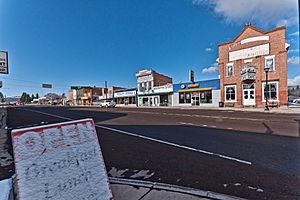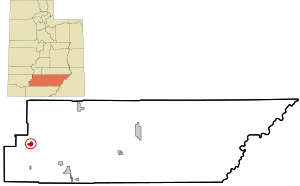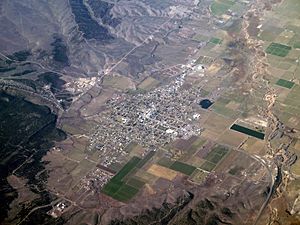Panguitch, Utah facts for kids
Quick facts for kids
Panguitch, Utah
|
|
|---|---|

Panguitch Main Street, April 2010
|
|

Location in Garfield County and state of Utah
|
|
| Country | United States |
| State | Utah |
| County | Garfield |
| Settled | 1864 |
| Incorporated | June 10, 1899 |
| Named for | Southern Paiute for "big fish" |
| Area | |
| • Total | 3.08 sq mi (7.99 km2) |
| • Land | 3.08 sq mi (7.99 km2) |
| • Water | 0.00 sq mi (0.00 km2) |
| Elevation | 6,624 ft (2,019 m) |
| Population
(2010)
|
|
| • Total | 1,520 |
| • Estimate
(2019)
|
1,682 |
| • Density | 545.40/sq mi (210.60/km2) |
| Time zone | UTC−7 (Mountain (MST)) |
| • Summer (DST) | UTC−6 (MDT) |
| ZIP code |
84759
|
| Area code(s) | 435 |
| FIPS code | 49-57740 |
| GNIS feature ID | 1444170 |
Panguitch ( PANG-gwitch) is a city in and the county seat of Garfield County, Utah, United States. The population was 1,520 at the 2010 census, and was estimated in 2018 to be 1,691. The name Panguitch comes from a Southern Paiute word meaning “Big Fish,” likely named after the plentiful nearby lakes hosting rainbow trout year-round.
Geography
Panguitch is located in western Garfield County at 37°49′20″N 112°26′5″W / 37.82222°N 112.43472°W (37.822234, -112.434650), in the valley of the Sevier River. U.S. Route 89 passes through the center of town, leading north 33 miles (53 km) to Junction and south 45 miles (72 km) to Orderville. Utah State Route 143 leads southwest from Panguitch 17 miles (27 km) to Panguitch Lake in Dixie National Forest.
According to the United States Census Bureau, the city has a total area of 2.1 square miles (5.5 km2), all of it land.
Climate
| Climate data for Panguitch, Utah (1981–2010) | |||||||||||||
|---|---|---|---|---|---|---|---|---|---|---|---|---|---|
| Month | Jan | Feb | Mar | Apr | May | Jun | Jul | Aug | Sep | Oct | Nov | Dec | Year |
| Average high °F (°C) | 41.0 (5.0) |
45.2 (7.3) |
53.4 (11.9) |
61.9 (16.6) |
71.4 (21.9) |
82.2 (27.9) |
87.1 (30.6) |
83.9 (28.8) |
77.4 (25.2) |
64.8 (18.2) |
50.6 (10.3) |
40.9 (4.9) |
63.3 (17.4) |
| Average low °F (°C) | 10.2 (−12.1) |
14.6 (−9.7) |
21.2 (−6.0) |
26.1 (−3.3) |
33.0 (0.6) |
39.7 (4.3) |
46.7 (8.2) |
45.5 (7.5) |
37.0 (2.8) |
26.4 (−3.1) |
17.5 (−8.1) |
10.0 (−12.2) |
27.3 (−2.6) |
| Average precipitation inches (mm) | 0.57 (14) |
0.59 (15) |
0.67 (17) |
0.57 (14) |
0.64 (16) |
0.49 (12) |
1.14 (29) |
1.80 (46) |
0.98 (25) |
1.24 (31) |
0.75 (19) |
0.46 (12) |
9.90 (251) |
| Average snowfall inches (cm) | 5.6 (14) |
5.3 (13) |
2.1 (5.3) |
0.9 (2.3) |
0.0 (0.0) |
0.0 (0.0) |
0.0 (0.0) |
0.0 (0.0) |
0.0 (0.0) |
0.3 (0.76) |
2.4 (6.1) |
2.6 (6.6) |
19.2 (49) |
| Source: NOAA | |||||||||||||
History
Panguitch was first settled in March 1864, when Jens Nielsen, a Danish convert to The Church of Jesus Christ of Latter-day Saints (LDS Church), led a group of pioneers eastward from Parowan and Beaver to the Sevier River. Due to the area's high elevation, 6,600 feet (2,000 m) above sea level, the settlers' initial crops did not mature and the community suffered severely during the first harsh winter. At a crisis point, seven men left the community to seek flour and foodstuffs from surrounding communities. Heavy snow forced the abandonment of wagons and teams, and the men finished their rescue mission on foot, reportedly by laying one quilt after another upon the snow to maintain their footing.
Due to a conflict with native tribes, the Black Hawk War in Utah, the community was temporarily abandoned in 1867 but was resettled in 1871. Some residents specializing in timber and livestock production were quite successful until economic shifts following World War I. Due to the establishment of Bryce Canyon National Park and the designation of nearby areas as national forests, tourism has since played a major role in the local economy.
Demographics
| Historical population | |||
|---|---|---|---|
| Census | Pop. | %± | |
| 1880 | 846 | — | |
| 1890 | 1,015 | 20.0% | |
| 1900 | 883 | −13.0% | |
| 1910 | 1,338 | 51.5% | |
| 1920 | 1,473 | 10.1% | |
| 1930 | 1,541 | 4.6% | |
| 1940 | 1,979 | 28.4% | |
| 1950 | 1,501 | −24.2% | |
| 1960 | 1,435 | −4.4% | |
| 1970 | 1,318 | −8.2% | |
| 1980 | 1,343 | 1.9% | |
| 1990 | 1,444 | 7.5% | |
| 2000 | 1,623 | 12.4% | |
| 2010 | 1,520 | −6.3% | |
| 2019 (est.) | 1,682 | 10.7% | |
| U.S. Decennial Census | |||
As of the census of 2000, there were 1,623 people, 502 households, and 392 families residing in the city. The population density was 1,194.0 people per square mile (460.8/km2). There were 620 housing units at an average density of 456.1 per square mile (176.0/km2). The racial makeup of the city was 94.02% White, 0.49% African American, 2.46% Native American, 0.12% Asian, 2.16% from other races, and 0.74% from two or more races. Hispanic or Latino of any race were 2.90% of the population.
There were 502 households, out of which 40.4% had children under the age of 18 living with them, 67.3% were married couples living together, 8.4% had a female householder with no husband present, and 21.9% were non-families. 19.1% of all households were made up of individuals, and 11.2% had someone living alone who was 65 years of age or older. The average household size was 3.05 and the average family size was 3.55.
In the city, the population was spread out, with 32.8% under the age of 18, 8.9% from 18 to 24, 23.2% from 25 to 44, 21.0% from 45 to 64, and 14.1% who were 65 years of age or older. The median age was 32 years. For every 100 females, there were 106.8 males. For every 100 females age 18 and over, there were 111.0 males.
The median income for a household in the city was $33,500, and the median income for a family was $39,904. Males had a median income of $28,259 versus $19,375 for females. The per capita income for the city was $12,439. About 6.2% of families and 9.6% of the population were below the poverty line, including 14.8% of those under age 18 and 6.6% of those age 65 or over.
Transportation
U.S. Highway 89 runs through Panguitch from Circleville in the north to Kanab in the south. State Route 143 runs south to Panguitch Lake.
Notable person
- Wayne Owens, Democratic Congressman who was born in Panguitch.
See also
 In Spanish: Panguitch (Utah) para niños
In Spanish: Panguitch (Utah) para niños


